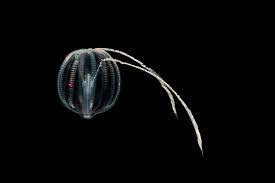Phylum Ctenophora
Ctenophores, often known as sea walnuts or comb jellies, are biradially symmetrical, diploblastic animals with a tissue-level organization that are entirely marine. The body has eight rows of ciliated comb plates on the outside that aid in movement. The existence of comb plates containing cilia, which are employed for propulsion, distinguishes the phylum. Ctenophores have a more complex body than sponges, although it is less complicated than bilaterians. They have tissue-level organization, just like cnidarians. Extracellular and intracellular digestion both are observed. Ctenophores exhibit a lot of bioluminescence (the ability of a living creature to emit light). They do not have stinging cells. In order to capture prey, ctenophores possess sticky cells called Colloblasts. The sexes are not divided. Sexual reproduction is the only way to reproduce.

External fertilization is used in conjunction with indirect development.Examples arePleurobrachia and Ctenoplana.

 ACME SMART PUBLICATION
ACME SMART PUBLICATION
